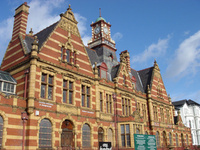Expert plasterers dip into history
 It’s easy to see why Victoria Baths, situated in the Manchester district of Chorlton-cum-Medlock, won the 2003 BBC Restoration challenge and just as easy to understand why the complex internal works require the touch of skilled craftsmen including Leeds-based traditional and fibrous plastering specialists Ornate Interiors.
It’s easy to see why Victoria Baths, situated in the Manchester district of Chorlton-cum-Medlock, won the 2003 BBC Restoration challenge and just as easy to understand why the complex internal works require the touch of skilled craftsmen including Leeds-based traditional and fibrous plastering specialists Ornate Interiors.Built 1903-06 by Manchester Corporation, the grade II* listed baths are testament to the pride and attention to detail taken by early 20th century municipal bodies in the creation of public buildings. The baths were in constant use until closure in 1993 and are home to the first ever ‘jacuzzi’ in a public baths in England, known as an Aerotone when installed in 1952.
Restoration Phase 1 of Victoria Baths started in earnest in March 2007 with completion due in June 2008 and will achieve the complete external and structural repair of the front block of the building.
Ornate Interiors, winner of the 2007 Plaisterers Trophy, was charged with a number of key internal plastering tasks by York and Manchester-based contractors William Anelay Ltd and architects Lloyd Evans Pritchard Ltd.
The extensive works carried out by the 19-year-old firm over a 14 week period included the traditional lime and horse hair method of plastering on many of the internal walls and ceilings as well as the restoration of a number of sections of damaged cornice.
Ronnie Clifford, MD of Ornate Interiors, explained: “During the initial site visit I was quite disappointed to see that yet another landmark building had been inappropriately repaired due to either a lack of knowledge or cost restraints.
“A good example of this kind of past neglect was in the committee room which had been wrongly patched in the past using gypsum materials which are neither sympathetic nor breathable.
“Therefore we had to remove all of the remaining gypsum plaster and this was reinstated using lime haired plaster,” added Ronnie who was also charged with creating a brand new lath and plaster ceiling within the Aerotone Room.
“Some of the lime plastering work involved running quirk moulds in situ. A quirk mould is the rounded external angle and was created using running moulds and a gig stick. A gig stick allows you to form curved radiuses when attached to a running mould to give varying radi.
“The running in situ method was used because these particular processes are true to the existing fabrication of the building having originally been carried out in this manner,” said Ronnie.
There were also several small areas of damaged cornice to repair throughout the building although given their size most were re-moulded in-situ by hand.
Lath and three coat lime plaster was applied to the ceilings in four rooms using horse hair whilst a number of internal walls were plastered using the three coat lime technique.
Ronnie went on “This involved blending into the existing ceilings using the penny washer and screw method. This is when the ceiling is screwed back to its original place allowing the penny washers to take their part of the weight.
“The historic fabric has been sympathetically restored using the appropriate methods and materials to suit the original construction of the building and it now has a far greater chance of surviving the rigours of the 21st Century,” added Ronnie.
Ornate Interiors Ltd specialise in the production of fibrous plaster mouldings principally for stately homes, listed buildings, hotels, churches, homes and theatres and also carry out traditional lime plastering and rendering demanded by the restoration of period properties throughout the UK and Ireland.
Restoration Phase 1 is being funded by Heritage Lottery Fund, English Heritage, the Restoration Fund and Manchester City Council with contributions for specific aspects of the project coming from Biffaward, the Pilsworth Environmental Company, the Mercers Company and the Zochonis Charitable Trust.
The building originally contained three bathing pools, one each for first and second class gentlemen and one for women and girls. The second class pool has now been floored over but the two remaining bathing areas provide an intriguing insight into the nature of society at the time.
Gill Wright of the Victoria Baths Trust explained: “First class gentlemen used the largest pool with the smallest pool being the domain of women and girls. It was a long time before the era of sexual equality!
“Even more bizarre was the way the water was pumped through from pool to pool with the women and girls bathing in water that had already served its use in the two male pools” added Gill. “But at least it was filtered before being re-used!”
The professional restoration work of Ornate Interiors and other specialist firms will ensure that these popular baths stay around for generations to come.
To find out more, visit Ornateinteriors.co.uk.

